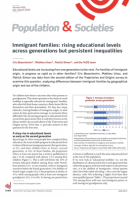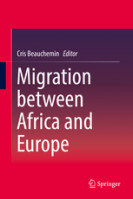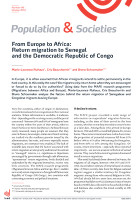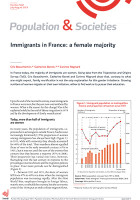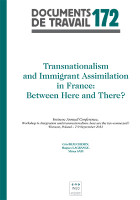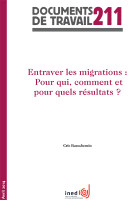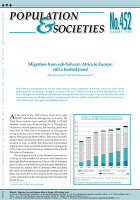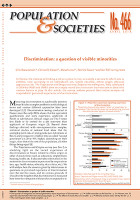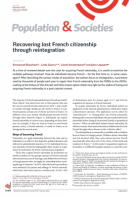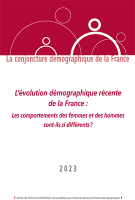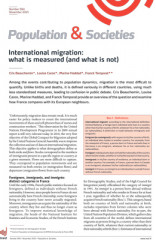
International migration: what is measured (and what is not)
Population and Societies
n° 594, November 2021
https://doi.org/10.3917/popsoc.594.0001
Among the events contributing to population dynamics, international migration is the most difficult to capture. Most countries do not have the tools to produce regular statistics. Definitions and measurement methods may vary from country to country. Since the early 2000s, international organizations such as the United Nations and the European Union have been promoting more standardized approaches that allow comparisons to be made. Whatever the indicator used, France appears to be one of the countries with the lowest immigration in Western Europe.
International migration, foreigner, immigrant, emigrant, migrant flow, migrant stock, migration statistics, France, Europe
Table of contents
- Appendix A References
1.
Among the events contributing to population dynamics, migration is the most difficult to quantify. Unlike births and deaths, it is defined variously in different countries, using much less standardized measures, leading to confusion in public debate. Cris Beauchemin, Louise Caron, Marine Haddad, and Franck Temporal provide an overview of the question and examine how France compares with its European neighbours.
‘Unfortunately, migration data remain weak. It is much easier for policy makers to count the international movements of shoes and cell-phones than of nurses and construction workers.’ This observation by the United Nations Development Programme in its 2009 annual report is still very relevant today. In 2018, the very first objective of the Global Compact for Migration adopted by the United Nations General Assembly was to improve the collection and use of data on international migration. This objective applies to what demographers define as both stocks andflows. Stocks correspond to the numbers of immigrants present in a specific region or country at a given moment. Flows are more difficult to capture. They correspond to population movements and are measured via both entries (or immigration flows) and departures (emigration flows) from each country.
1.1. Foreigners, immigrants, andimmigrés: distinct categories in France
Until the early 1990s, French public statistics focused on foreigners, defined as individuals without French nationality. However, since people born in France do not automatically have French citizenship, some foreigners living in the country have never actually migrated. Moreover, immigrants can acquire the nationality of the country where they live and thus no longer count as foreigners. To improve statistical knowledge of migration, the heads of the National Institute for Statistics and Economic Studies, of the French Institute for Demographic Studies, and of the High Council for Integration jointly officialized the category of immigré in 1991. An immigré is a person born abroad without French nationality and who resides in France for at least 1 year, regardless of whether he or she subsequently acquires French nationality (Box 1). This category, based both on country of birth and nationality at birth, excludes repatriates from former colonies who were born abroad with French nationality. For its part, the United Nations Population Division, which gathers data from all countries of the world, defines international migrants as persons living in a country other than their country of birth, whatever their current nationality or their nationality at birth (Box 1). Estimates of international migrant numbers vary according to the definition adopted. Under the French definition, immigrants (immigrés) represented 10% of the resident population of France in 2019 versus 13% under the international definition adopted by the United Nations [1] (Figure 1).

1.1.1. Box 1. Definitions
International migrant: according to the international definition (United Nations), a foreign-born individual who lives in a country other than his/her country of birth, whatever his or her nationality (or nationalities). A distinction is made between immigrants and emigrants.
Emigrant (or outmigrant): with respect to his/her country of birth, an individual who resides in another country. For example, from the viewpoint of France, a person born in France and who lives in Germany is an emigrant, whatever his or her nationality (or nationalities).
Foreigner: individual who does not hold the nationality of the country where he/she resides, whether or not he/she was born in that country.
Immigrant: in his/her country of residence, an individual born in another country. For example, in France, a person born in Canada is an immigrant, whatever his/her nationality (or nationalities).
Immigré: In France, an immigré is an individual born outside France without French nationality.
1.2. International perspectives on migrant stocks
The international definition of migrants has the advantage of permitting comparisons between countries. In 2019, for example, France ranked 16th among EU-28 immigration countries. Despite its long history of immigration and the effects of decolonization specific to the French context, its share of immigrants is barely above the European average (12%; Figure 2) and well behind neighbouring Germany (18%). With almost half of its population born abroad (47%), Luxembourg is a special case that illustrates the diverse range of situations in Europe and the tendency that small countries often receive a higher proportion of migrants than large ones.

Counting immigrants is not the most difficult challenge; they can be identified in population censuses (or population registers in countries where these exist) via their country of birth. Counting emigrants (i.e. people who have left their country of birth; Box 1) is much more problematic. It was not until the turn of the 21st century that major international institutions (World Bank, United Nations, OECD) decided to assemble census data from different countries to establish emigration statistics. For example, the stock of emigrants from France can be established by counting all people born in France and recorded in censuses across all other countries of the world. This operation is complex because it involves assembling and standardizing data from censuses worldwide conducted in different years and whose definitions may vary. For example, it is estimated that in 2020, out of every 100 people born in France, almost 4 were living abroad. This proportion, which gives a measure of the intensity of international outmigration, is close to 6% for Italy and Belgium and 20% for Luxembourg. France is a country where the relative scale of departures is limited compared with the European average (close to 9%)1 However, the intensity of international outmigration is greater than what is observed in other areas of the world. On average, in 2020, out of every 100 people born in a country in Africa, 3 have changed their country of residence; the proportion translates to 2.5% in Asia and 1.5% in North America.
1.3. Migration’s role in population growth
Counting migrant stocks does not shed light on population movements over time. So how can we determine the impact of migrant entries and departures on a country’s population growth (or decline)? This is performed by calculating net migration, i.e. the difference in numbers of arrivals and departures over a year. But this operation is delicate, as few countries in the world have accurate measures of migrant flows. In 2017, only 45 countries could provide the United Nations with statistics on entries and departures for stays of at least 12 months. So in most countries, net migration is estimated indirectly. It is deduced from the demographic equation whereby population change in a given territory between two dates (population growth) results from the difference between births and deaths (natural growth) and between inflows and outflows (net migration). As natural growth is known thanks to civil registration data, and population change is known via successive censuses, net migration can be determined indirectly. However, this residual method is still imperfect as the net migration figures obtained are distorted by the inaccuracies of censuses and civil registration data which are far from exhaustive in certain countries. It is more prudent to use the term apparent net migration. Net migration can be re-estimated more accurately ex post by including natural growth, net migration, and adjustments for census inaccuracy in the demographic equation, thus restoring consistency between the statistical information sources [2].
The data that Eurostat has collected from national statistical offices are used to approximate the contribution of migration to population growth in the European Union countries. The results shown in Figure 3 take account of initial adjustments and may be amended further. It is now estimated that over the period 2000–2019, the French population grew annually by 4 per 1,000 on average (3.7 per 1,000). Most of this growth is attributable to natural increase. In the other countries, by contrast, international migration is the main driver of population growth.

1.4. Measuring immigration flows
How can we separate inflows and outflows in the measurement of net migration? It is difficult to answer this question precisely in most countries (and impossible in many), as information sources are rare or incomplete. In France, two information sources are used to measure immigration flows. Now that the census is based on annual surveys, entries can be estimated using respondents’ answers to questions about their year of arrival in France and their place of residence in the previous year [3]. Theoretically, this source covers the entire resident population, although some people—notably the most recent arrivals—may be omitted. They can nonetheless be counted later, after their inclusion in the census. The other source is the AGDREF database of foreign residents in France (Application de gestion des dossiers des ressortissants étrangers en France), managed by the Ministry of the Interior. It can be used to count the annual number of people who receive a first residence permit valid for at least 1 year [4]. These statistics are partial because immigrants without a residence permit are excluded. This is the case for most children who, with a few exceptions, are exempted from this obligation. Citizens of Switzerland and the European Economic Area (including French people returning from residence abroad) are also excluded, even though these categories accounted for almost half of all arrivals in France in 2016 and 2017 [3]. Last, so-called undocumented immigrants are absent from the AGDREF database, although they are counted when their situation is regularized. Given their differing properties, these two information sources (the census and AGDREF) necessarily provide dissimilar results for the number and characteristics of new arrivals. Moreover, differences in registration methods may produce disparities in estimates of similar populations.
France’s neighbours also have a dual system for counting immigration flows. Eurostat maintains a database of flows measured by national statistical offices from censuses and population registers. The OECD assembles information on residence permits to establish statistical series on so-called permanent immigrants who hold a residence permit that, in principle, can be renewed indefinitely (in reality, renewal is often subject to certain conditions).2 The two sources necessarily produce different results (Figure 4). But in all cases, France, alongside Italy, is the Western European country that received the fewest immigrants—proportionally speaking—in 2019.

1.5. Emigration: the Cinderella of population statistics
In practice, no one can tell whether someone who arrives in a country will actually settle permanently there: an indefinite right to stay does not correspond to an obligation. Yet departures are very inadequately measured in most countries of the world, and France is no exception. Statistical systems reflect the much greater importance attached by governments to counting individuals who enter and settle in their country rather than to those who leave. Some countries, in northern Europe especially, have population registers that provide a means to measure emigration. In theory, all individuals are required to report not only their arrival as a new resident but also their departure. In many cases, however, fewer than half of all departures are actually reported [5]. Longitudinal data collected on a representative sample of the resident population provide an alternative information source. A panel of individuals is monitored over time, and a person is considered to have emigrated when he or she disappears from the sample for no other apparent reason (death, change of address, data collection or matching error). Applying the method to France via partial matching of successive censuses between 1975 and 1999, it was estimated that between a quarter and a third of immigrants present at the time of a given census had left the country after a period of 7 to 9 years [6]. However, in 2004 the French population census was transformed into an annual survey covering only part of the population, so this method is now inapplicable. The annual census surveys can nonetheless be used to deduce departures by subtracting entries from net migration. In 2017, for example, an estimated 215,000 people left France, of whom close to 29% were immigrants (immigrés) and 71% were non-immigrants (non-immigrés) [3]. While useful for furthering knowledge of migration flows, the accuracy of these calculations depends on the precision of measures of net migration and entries. Other administrative sources provide very partial information on departures. For foreigners, they include statistics on deportations and assisted voluntary returns. For French nationals, consular data are available, although registrations are voluntary and highly dependent on the electoral calendar (French expatriates must register at a consulate to vote).
1.6. Towards an enlightened use of migration statistics
As we have seen, statistics on international migration are often imperfect. While relatively accurate counts of international migrant stocks can be obtained when census data are available, measures of immigration flows, and more especially emigration flows, are still limited in most countries of the world. In France, progress has been achieved in recent years, although scope remains for improving estimates of flows and net migration. That said, available statistics already show clearly that the role of migration in population change remains small. While France has historically been a receiving country, it has become one of the countries of Western Europe where immigration is lowest proportionally, whatever the measure applied. Moreover, it should not be forgotten that France is also an emigration country. A significant share of its immigrants leave within a few years after arrival, and growing numbers of French nationals are also moving abroad. Today, the proportion of native-born French people who migrate out of France is higher than the proportion of individuals born in Africa or Asia who migrate out of their country of birth.
Appendix A References
-
[1] United Nations, Department of Economic and Social Affairs, 2020, International migration stock 2020, World population prospects 2019.
-
[2] Héran F., Toulemon L., 2005, What happens when the census population figure does not match the estimates? Population & Societies, 411, April.
-
[3] Lê J., 2021, En 2017, 44 % de la hausse de la population provient des immigrés, Insee Première, 1849, April.
-
[4] d’Albis H., Boubtane E., 2015, Characteristics of migration flows to France based on residence permit data (1998–2013), Population, 70(3), 461–496.
-
[5] Poulain M., Herm A., 2013, Central population registers as a source of demographic statistics in Europe, Population, 68(2), 183–212.
-
[6] Solignac M., 2018,
-
Immigrant emigration: An overlooked dimension of geographical mobility, Population, 73(4), 659–684.
Europe as defined in the statistical tables of the United Nations, and not the European Union.
In most cases, migrants who receive a permanent residence permit have been in France for several years and have already held one or more temporary permits.
Among the events contributing to population dynamics, international migration is the most difficult to capture. Most countries do not have the tools to produce regular statistics. Definitions and measurement methods may vary from country to country. Since the early 2000s, international organizations such as the United Nations and the European Union have been promoting more standardized approaches that allow comparisons to be made. Whatever the indicator used, France appears to be one of the countries with the lowest immigration in Western Europe.
Cite the article
Cris Beauchemin, Louise Caron, Marine Haddad, Franck Temporal - "Towards an enlightened use of migration statistics"
Popetsoc 594, November 2021
 This document may be reproduced free of charge on paper or online using our Creative Commons licence.
This document may be reproduced free of charge on paper or online using our Creative Commons licence.




